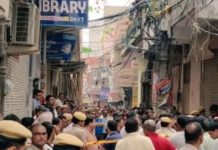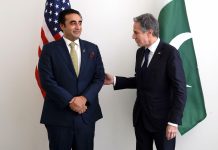Overnight, Modi became the human avtar to deliver Ram-avtar. Therefore when PM goes campaigning in the next few months, the Rambaan, or panacea, as they say is enough to work wonders. BY KUMKUM CHADHA

Even if industrialist Mukesh Ambani had not spelt it out, from this year on, India would have two diwalis. Looking at the enthusiasm of the temple opening at Ayodhya on January 22, 2024 this is kind of a given.
As things have panned out, Indians across the length and breadth of the country are celebrating Ram’s temple-abode more than they did on his return to Ayodhya after a 14-year long exile.
In this context, the tent to temple phrase has caught on given that till Ram’s idol was installed in the grand temple, the God lived in a makeshift temple: actually under a tent.
A new idol, some 51 inch, sculpted by Mysuru’s Arun Yogiraj, has been installed in the new temple. If reports are anything to go by, the idols which were worshipped for years in the makeshift shrine, will also find a place in the new temple.
If there are any questions on the need for a new idol when the old exists, the answer is best summed up by the Shri Ram Janambhoomi Teertha Kshetra Trust: the idol is diminutive and can only be seen from a distance of less than 30 feet.
However in the BJP’s scheme of things, if the temple is bhavya, grand, then how can the idol fall short?
Rewind to 1992: the Babri masjid was demolished and the idol of Ram was shifted to a tent set up at the demolition site and worshipped.
As for the maths, here is the 14 to 500 years calculation:
It was after 14 years of exile that Ram returned to Ayodhya which till now was celebrated as Deepavali: a very significant and perhaps most important festival in North India.
The 500 years story dates back to the year 1528. A mosque was built by Mughal Emperor Babar at the birthplace of Lord Ram where a temple had originally existed.
Following court battles from 1885 through 2019, the Supreme Court gave the go-ahead for the temple construction in Ayodhya while allotting 5 acres of land to Muslims for building a mosque in Ayodhya.
Putting the pieces together, it was in 1885 that Mahant Raghubir Das filed a suit seeking permission to build a canopy on the Ram chabutra, courtyard, adjoining the mosque. The plea was rejected; in 1950, Hindus filed a suit to conduct pujas which were allowed. This followed pleas and counter pleas till the conclusion in 2019 with a court order that Hindus welcomed and Muslims regretted.
In 2020, Prime Minister Narendra Modi laid the foundation stone for the temple in Ayodhya that was completed in record time.
Therefore what the world witnessed on January 22, 2024 was the opening of the temple and consecration of the Ram idol at Ayodhya: dubbed as grand and majestic by most.
This was a second Diwali to put it mildly when lakhs of diyas were lit in Ayodhya and homes across the country: a second Diwali more joyous and participatory than the original that India celebrates any time between September and November depending on the lunar calendar.
Prime Minister Narendra Modi had given a clarion call for Indians to light diyas at their homes to mark the temple opening in Ayodhya: “Light a diya at home on January 22. That day should be Diwali across India”, Mr Modi told the nation. The believers went that extra mile to honour what the Prime Minister had wished.
This “second Diwali” may be a first in India but it is here to stay and perhaps to be celebrated with greater enthusiasm and gusto. Therefore Ambani was not off the mark when he said from here on, India would celebrate two Diwalis. In other words, put the 14 years to the 500 in action so to say.
As for Prime Minister Narendra Modi, he self-imposed a regimen wherein he slept on the floor and lived on coconut water for eleven days. The anushthan or special ritual is observed ahead of the consecration or pran pratishtha of an idol: in this case Ram in Ayodhya.
This neither stopped his work nor weakened his resolve. Not surprising because PM Modi is accustomed to adhering to regimens that common people may find difficult to follow.
Remember Navratri? PM Modi routinely fasts for nine days and if reports are anything to go by, he survives on a liquid diet: mostly water.
During his US visit in his first term, he followed this regimen despite the fasting period clashing with the state banquets during his five-day visit.
The White House had then created and curated a special grain-less menu, comprising salads and fruits.
Back home, even during election campaigns, he has observed the Navratri fasts surviving primarily on lemon water during his hectic tours.
Against this backdrop the pre-ritual fast for the Ram temple should not come as a surprise.
However, Modi is not alone in devotion. There are others:
A bookseller has offered a unique edition of the Ramayana, also said to be the most expensive, which is printed on paper from France, a “three floor” box made of walnut wood, sourced from the US and organic ink, imported from Japan. The claim: this special edition would last 400 years and can be read by four generations.
Whether PM Modi will take well to so much imported material being used for an Indian scripture remains to be seen given that he is a votary of Make in India.
Then there is a 108 feet long incense stick from Gujarat which is said to last for over a month; a themed necklace reportedly studded with 5,000 American diamonds; a lock and key weighing 400 kgs from Aligarh; a 2000 plus kg bell; a 1100 kg giant lamp good to hold 851 kg ghee and a 1000 plus kg ladoo from Hyderabad.
While on food, some 7000 kg Ram Halwa for devotees was prepared by a Nagpur chef and chappan bhog, 56 items petha-prasad was dispatched from a famous sweetmeat manufacturer in Agra. This comprised 56 flavours weighing 56 quintals.
The list is long and in one sense unending. But that is a mere subtext.
The storyline is about religion and politics jointly spearheaded by Prime Minister Modi and the BJP in its current playground: Ayodhya.
At one level it is a dream and a promise fulfilled. At another, it is showcasing Prime Minister Modi as a man who can do what others cannot: one who delivers and one who not only puts his men to work but also ensures that they are deadline-driven. The culmination of the temple in Ayodhya and the installation of Ram’s idol therein is testimony enough.
The naysayers, Opposition parties included, may have slammed the move but that cacophony was drowned in the immense faith and support that came from the people across the country. Believers were willing to worship the Prime Minister for this feat. Others marvelled at the grandeur and scale of this mammoth project, grudgingly accepting the Modi hai to mumkin hai, with Modi everything is possible, slogan.
Add to this Modi’s work culture where not a single minister, including heavy weight Amit Shah, was seen in Ayodhya. If some were packed off to different temples in India to offer prayers, others stayed put and visited temples in Delhi. Whether this was to make it a non-government event and focus only on people, celebrities and ordinary men and women, is anyone’s guess.
Having said this, one must give it to the BJP and its cadres that it not only marketed the event well but displayed its organisational capabilities to the hilt.
The way it has played out encompassing a large mass, speaks a lot about BJP’s ability to dramatically transform an event into a spectacle and that too at a scale that will remain etched in memory for years to come. In the process, it awakened and energized people’s dormant religious beliefs and showcased them as never before.
The outpouring of multitudes with gifts, devotion and prayers does say something about the BJP touching a chord and awakening a suppressed and neglected sentiment: in this case devotion to Ram.
Contrary to critics slamming the temple as being divisive, Prime Minister Modi went that extra mile to say that Ram unites. If events are anything to go by, he is spot on.
Naysayers are projecting this purely as an electoral exercise.
Looking at the way events have unfolded, this now seems a half-truth.
At one level, the BJP is a political party which is in election mode 24×7. So to see the Ayodhya jamboree sans elections would be not only naïve but plain stupid to say the least.
For starters, the timing of throwing open the temple a few months before the general elections says it all. Add to this, converting it into a mega event encompassing major cities and villages is not without a purpose.
To put it simply, Modi is being “packaged and electorally sold” as one who has the heft to give to the country something denied for 500 years. The fan-fare that came with it did wonders because it made even non-believers sit up and “wow” the moment.
Overnight, Modi became the human avtar to deliver Ram-avtar or Ram’s incarnation. Therefore when Prime Minister Modi goes campaigning in the next few months, the Rambaan, or panacea, as they say is enough to work wonders.
Having said that, one cannot take away the fact that PM Modi ensured completion and did in one sense gift to the Hindus something long overdue. That they would remain indebted to him for many years is a given. In this context, one would need to look beyond politics and accept that the ocean of people who converged in Ayodhya on the morning of January 22,2024 were driven by both emotion and devotion. It was Ram and Modi in that order. To Ram they paid obeisance and to Modi expressed their gratitude.
Pitch this sentiment against political gains and it would not be wrong to conclude that the mega event India and the world witnessed on January 22 this year, backed with the emotion, devotion and sentiment of the common man, would go beyond one election.













